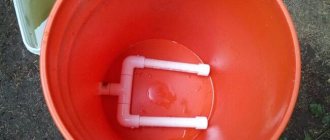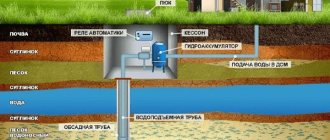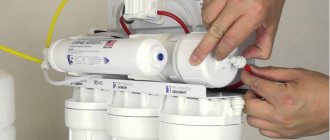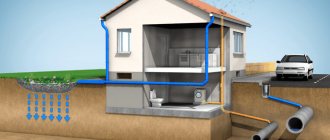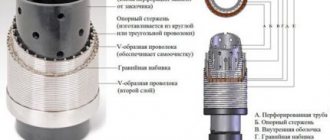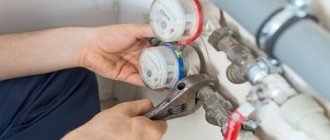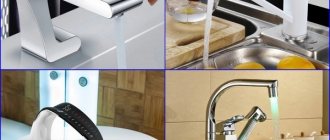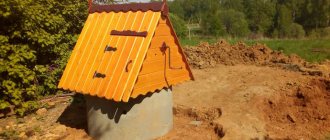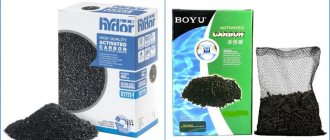Here you will learn:
- Why do you need to purify water?
- If there is no filter
- Features of homemade filters
- How to choose filter media
- Activated carbon device for dirty water purification
- Three-flask design for full-fledged water supply
- Homemade cleaning structure for a well
- How to make your own cleaning structure for a well
- Sand option for the pool
A do-it-yourself water purification filter can be made using any suitable filtration material - coal, sand, cotton wool, lutrasil. The easiest and most effective way is to use coal.
Why is filtering necessary?
When building a private house, many land owners mistakenly think that if the extracted liquid from a well or borehole does not have foreign odors and is cloudy in color, then it is “useful.” However, experience shows that the estimate includes seven percent of the total cost of constructing a residential building for water treatment. This is no coincidence, since an apparently healthy liquid may contain such a “bouquet” of undissolved impurities that its use is sometimes unsafe for health. In addition, it negatively affects the operation of household appliances, including water heating equipment. In the latter case, the liquid should not be hard.
Let's summarize. Pros of filtering:
- Allows you to get rid of impurities of heavy metals, calcium and magnesium salts, and other toxic substances.
- Removes pathogenic microorganisms (bacteria and viruses).
- Increases the service life of plumbing equipment and household appliances. Prevents the formation of scale and sediment on the walls of devices.
- Counteracts harmful effects on the body.
- Costs for purchasing medications are minimized.
It is worth noting that only the sanitary and epidemiological station service can cope with bacteriological contamination. This means that in order to avoid poisoning by pathogenic microorganisms, the makeshift structure must be removed over time and replaced with industrial equipment.
Radial settling tanks
Radial settling tank
The next settling tank under consideration is a type of vertical settling tank - radial. Its main differences are its significantly smaller height (10-15 cm) and larger diameter, ranging from 16 to 60 meters, and in rare cases even up to 100 meters.
The main purpose of such structures is the purification of highly turbid waters, as well as the purification of water in industrial sewerage systems.
Water is supplied through pipes to the central part of the sump; in the upper part there is a circular weir for its removal. Removal of fallen sediment from the bottom is carried out using scrapers.
A radial settling tank is usually used when the daily capacity of treatment facilities exceeds 20 thousand cubic meters. meters, removing about 50% of impurities.
We assemble the water filter ourselves and select the filler
Initially, you need to correctly calculate the volume of liquid entering the residential building. To do this, take into account the number of people living and points of consumption (garage, barn, swimming pool, outdoor shower, watering a greenhouse, vegetable garden, flower beds, etc.). The volume of the container depends on this. All components must fit into it. As a rule, the container is filled layer by layer with natural raw materials, which are cheap to the consumer. First, the liquid is filtered through a layer of washed and dried sand of any kind. In this way, it gets rid of small debris and heavy chemical compounds. Then it passes through gravel, which cuts off large inclusions. Activated carbon or a modern cheap product such as “zeolite” do not allow suspended metals and salts to pass through, destroy organic matter and waste products from the activities of agricultural complexes. The final stage is the penetration of moisture through cotton textiles (gauze, medical bandage, etc.). Natural materials instantly become clogged with unwanted particles, so they have to be changed frequently. In addition, they are susceptible to rotting, which negatively affects the taste and smell. Therefore, an excellent alternative is the synthetic geomaterial “Lutrasil”, which is highly resistant to various types of pollution.
Quartz or river sand for a DIY water filtration system
The mineral contains virtually no clay admixture. This indicates that the incoming liquid is cleared of foreign substances harmful to the human body. This type of sand contains large amounts of silicon oxide. Therefore, it is preferable as a filler for rough mechanical cleaning. If the ingredient is of good quality, which is pre-calcined in the oven, then there is no need to replace it. It is necessary to periodically top up to a certain level.
Carbon additive
Do not pay attention to coal made from coniferous wood (pine, spruce, fir, etc.). For filtration, an absorbent made from:
- birch;
- coconut;
- shells of apricot kernels or other fruits;
- peat bog;
- deciduous raw materials;
- finished hard or anthracite coal.
The material is characterized by a high ability to maximize the absorption of harmful toxic particles, for example, such as phenol, chloroform.
"Lutrasil"
The advantages of non-woven polypropylene synthetic material include:
- Environmental friendliness of raw materials.
- Excellent water permeability.
- Resistance to breaking loads.
- Wear-resistant - used for 5-8 years.
- Excellent resistance to various stains.
"Zeolite"
The sorbent has good retention characteristics. Neutralizes liquid from organic compounds, hazardous chemicals, heavy metal ions and breakdown products of agricultural processing (nitrates, nitrites, phenols, etc.). It is used as an independent filler and can be mixed with any type of sand.
MBFT-75 Membrane for 75GPD
SF-mix Clack up to 0.8 m3/h
SF-mix Runxin up to 0.8 m3/h
Down with the smell and smoke
The next item that often worries city residents is air purification. Finding such a device on the market is still very difficult. So again we have to think about how to make a carbon air filter with our own hands. If it is available, for example, in a hood, then you need to see whether it is disposable or reusable. If it is reusable, then it will be enough to open it, remove the used carbon, rinse thoroughly, dry it and add new filler. If it’s disposable, you’ll have to buy a new one or assemble a carbon filter for the hood yourself.
All components are reassembled. This can be a standard housing for the hood, into which a structure is inserted from two mosquito nets connected to each other with activated carbon poured between them, ground to the state of granules or powder, depending on the density of the net. Some suggest using sieves with metal meshes of various diameters. You need to pour coal into a sieve of a larger diameter, press it with the bottom of a sieve of a smaller diameter and secure it well with sealant. And install this structure in the hood body. The peculiarity of such a filter is that the density of its absorbent will have to be adjusted to the power of the hood fan. Since a layer that is too thick and dense may not allow enough air to pass through, and a thin and sparse layer will not cope with its cleaning functions.
How to make a carbon filter for ventilation with your own hands, you can follow the following instructions. For its manufacture, two pipes of different diameters, plugs, mesh, agrofibre and coal are used. Holes are drilled in the pipes. Then each is wrapped with mesh and agrofibre. The inner pipe is installed in the plug exactly in the center and secured with glue or other means. A larger volume pipe is installed later and is also secured. Coal is poured between them. All that remains is to put one more plug on top. The filter is ready.
How to make a water sediment filter with your own hands based on activated carbon
You will find this type of filler in any pharmacy chain. It is inexpensive and lightweight. Retains mineral ingredients and toxic substances with equal quality. After passing through the composition, the moisture becomes transparent without any foreign odors. To cleanse 1 liter, only one tablet of charcoal is needed. However, for the device to work effectively, it is better to use several pieces.
Small camping devices
Coal is sold at any hardware store. To do this, choose granular material, since a powdery structure can penetrate into the purified liquid, while a coarse structure will not provide a good absorbent effect. But in nature, purchased material will not always be in your backpack. You'll have to make it yourself. To do this, take any hardwood (preferably birch). Chop the wood into small pieces, place them in any metal container and place it on an open fire. The wood will turn red, remove the coal. As a last resort, ash is also suitable for filtration.
Making a carbon purifier
The base can be a drink bottle of any size or a food container. In addition, you will need:
- fabric cotton base;
- river sand;
- small pebbles;
- tools: knife, awl, electrical tape and, if available, silicone moisture-resistant glue.
Further actions:
- Cut off the bottom of the bottle. Liquid will flow here.
- On the outlet valve, drill a large hole or make several small holes using a sharp object.
- After screwing on the perforated lid, hang the entire structure on a tree branch and begin filling the absorbent layers. Place fabric folded in several layers on the bottom.
- Place fine-grained coal, sand and gravel in turn on top.
- Cover the top of the device with any material to prevent foreign objects from leaking into the structure.
How to make and assemble a water filter (purifier) from a polyvinyl chloride pipe yourself
The method for making a makeshift system is as follows:
- Cut two pieces of different sizes from the plastic pipeline. Place any cotton material inside the larger part.
- Insert the cut neck of a soda or beer bottle with the threaded hole facing up. Use electrical tape to seal. Make several holes in the screw cap using a sharp object.
- Place padding polyester in the pipe.
- Pour any charcoal filler into the smaller part.
- Connect both products using a threaded connection, so that the cleaning equipment with coal is at the bottom.
- Attach bottles to both sides of the homemade block. Liquid will flow from above, and already filtered liquid will flow out from the lower container.
The absorbent is not laid too tightly, since the compacted layer can delay the passage of moisture.
Content
How to make a water filter with your own hands to get truly drinkable water
Often, water from wells is so contaminated with various impurities that it cannot be used even for laundry and washing dishes without preliminary purification. A homemade water filter will help you. Many note that ready-made filters sold in stores are not very efficient, and the need to constantly replace cartridges makes the device quite expensive to operate. The basis of a homemade water filter is ordinary cotton wool and gauze or charcoal.
What are aquarium water filters made of?
To create a homemade design, you must have the following materials:
- Two medical syringes.
- A spray bottle, for example, from dishwashing detergent.
- Hard sponge.
- Fasteners
Cut off the tips of the syringes and throw away the moving parts. Attach the blanks to each other. Using a soldering iron, make perforations over the entire area of the medical instrument. Fill the improvised filter element with some kind of granulite, for example, zeolite. The flexible spray hose must be cassette length. The last step is to wrap the sponge around the craft and secure it with wire.
Sand filler for pool
AMETHYST - 02 M Residential building for up to 10 people or up to 2 cubic meters/day.
Aeration unit AS-1054 VO-90
Main table dispenser AquaPro 919H/RO (hot and cold water)
You can create a filter system yourself if you intend to use a small displacement. Otherwise, a home-made device will not be able to properly purify water. For large containers, it is better to purchase specialized equipment from companies that have been successfully working in this field for a long time, for example, in our company.
To create a temporary cleaner, you will need a plastic container of the required volume from 25 to 50 liters with pipes inserted at the top and bottom for inlet and outlet of liquid. The filler is created from small pebbles and river or quartz sand, which are separated from each other by geotextiles. A layer of lutrasil is required on top to avoid the formation of a sand funnel. The entire system operates using a connected pump.
Choosing a water treatment system for a summer residence
When choosing solutions for organizing a water purification system for a dacha, we were guided by our basic requirements and operating features. In our case, we needed an inexpensive and small system that could provide water for the periodic residence of three people at the dacha during the dacha season. Many solutions that are offered on the market are designed for country houses for permanent residence, but we needed a system only for the summer season, and so that it would not need to be dismantled each time for the winter and taken to the city for storage. At the same time, the new water purification system should reduce water hardness and reduce iron content.
As a result, we have developed very clear requirements for the new water treatment system:
- Low cost of the system itself, consumables and its maintenance;
- The ability to leave it at the dacha for the winter without dismantling the entire system;
- Small dimensions , since there is no separate room for installing the system;
- Ease of maintenance;
- Improving water quality according to two main indicators for us: hardness and iron content.
During the search for solutions for organizing water treatment that meet our requirements, only two options were found: 1. Organize a water purification system based on the universal filter “Ecomaster Galaxy MX”; 2. Organize a water purification system based on several mainline water filters of the Big Blue 20 standard and suitable replacement cartridges.
Downhole equipment
Drinking in individual wells also needs to be thoroughly cleaned, because it contains large quantities of small particles of clay, sand suspensions, and decay products of flora, fauna and human activity. The production of the device requires precise calculations and is within the capabilities of engineers with special knowledge. If you decide to create a device yourself, then read the information about what methods you can use.
gravel element
The main condition for effective work is the correct selection of factions. The grain size of the filling should be eight times larger than the sand particles. After selecting the filler, the granules are poured onto the bottom of the source in a layer of at least 50 cm.
Hole filter
Making a perforated part is simple. You will need an electric drill and a drill bit. The photo shows the creation process:
Slotted
In the picture you can see how carefully the device is made. To avoid making mistakes, we do not recommend that you make a design using a makeshift method. It is better to purchase the mechanism in a specialized store, for example, “Water of the Fatherland”.
Wire mesh device
It will not be possible to create this design yourself, since in order to correctly and accurately reproduce the gap between the turns of wire, welding with a special tool is required in thousands of places.
Let's sum it up
So, making a carbon filter with your own hands is not difficult. Anyone can handle this. However, this method should be used as a last resort, since such devices, made at home by incompetent craftsmen, can do more harm than help in water purification. The desire to save and preserve the family budget can lead to more significant costs due to possible poisoning of water passed through such filters.
How to make a water filter for a faucet with your own hands at home
You can solve the problem using available materials. Below we provide you with instructions on how to make the cleaner.
From a plastic bucket with a lid and a five-liter bottle
Cut off the bottom of a bottled liquid container. Make a hole of a suitable diameter in the bucket. Connect the two elements together with fum tape. Activated carbon is used as a filler. It is advisable to filter the liquid twice before drinking.
From two bottles
In addition to containers, you must have geotextiles or cotton fabric with you. If you are outdoors near a pond, then take sand from there and calcine it over a fire. The resulting coals are also suitable as a filler. Pour the raw materials into one bottle without a bottom, one at a time.
Main table dispenser AquaPro 929CH/RO (cooling/heating)
Floor dispenser AquaPro 311 (empty, without cooling)
Floor-standing dispenser AquaPro 6207CH (cooling/heating/room temp.)
From paper
This method can be used if you need a small amount of drinking liquid, since the paper towel will quickly become limp and will have to be replaced with a new one. Create an improvised funnel and insert it into a glass, place a paper bag inside the container, preferably from newspaper.
